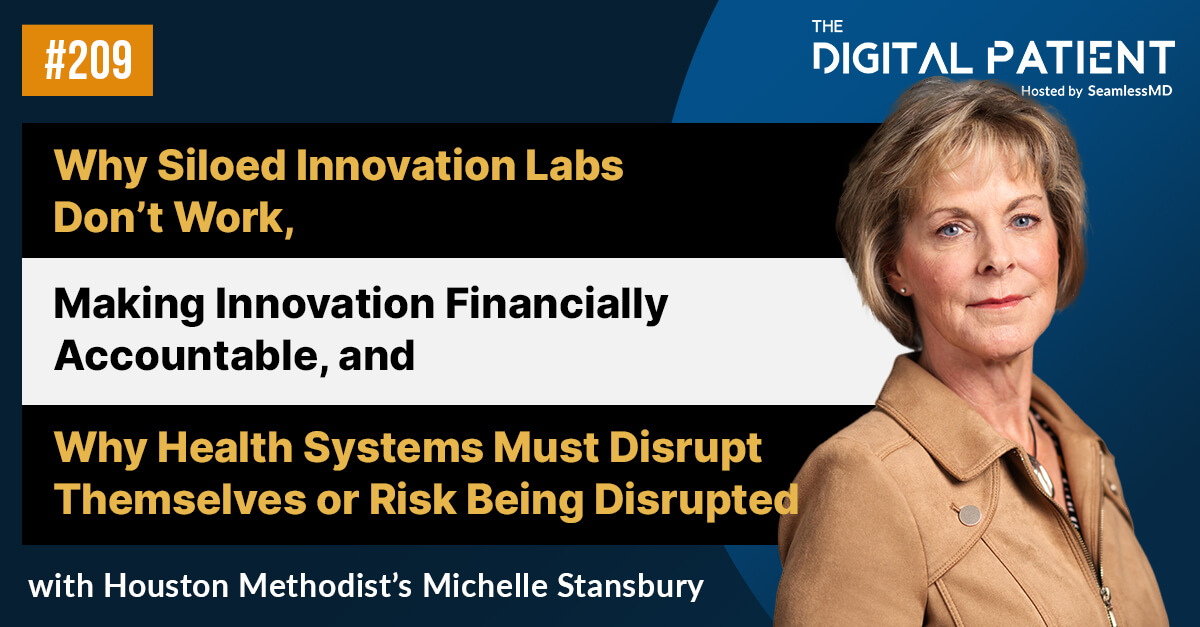Subscribe on: RSS | SPOTIFY | APPLE PODCAST | GOOGLE | BREAKER | ANCHOR
On this episode of "The Digital Patient" podcast, hosts Alan Sardana & Dr. Joshua Liu speak with Dr. Dusadee Sarangarm, Chief Medical Information Officer at the University of New Mexico, about "Leveraging Human-Centered Design and Health Literacy to Deliver Digital Experiences Your Mom Can Use and Providing Patient Education in the world of Dr. Google". Click the play button to listen or read the show notes below.
Audio:
Video:
Guest(s):
- Dr. Dusadee Sarangarm, Chief Medical Information Officer & ER doctor at the University of New Mexico
- Dr. Joshua Liu (@joshuapliu), Co-founder & CEO at SeamlessMD
Episode 84 - Show Notes:
[00:00] Introducing Dr. Dusadee Sarangarm, Chief Medical Information Officer at University of New Mexico;
[2:00] How Dr. Sarangarm was always into technology and won a supercomputing challenge back in high school;
[3:10] Why Dr. Sarangarm became an ER doctor following her destiny – as she was named Dusadee, which means Doctor in Thai;
[4:10] How informatics fell into Dr. Sarangarm’s lap after repeatedly taking on more responsibilities around the EMR during her residency as a way to help her colleagues;
[13:15] Why Dr. Sarangarm focuses on people more than technology since people – patients and her colleagues – are the ones who benefit from the technology and make the job fun;
[8:08] Why Dr. Sarangarm believes disaster recovery is more difficult than disaster response in regards to technology as entropy naturally develops following the response, which means systems that were built to accommodate short term needs now need to be adapted for long term sustainability;
[11:00] Why Dr. Sarangarm focuses on her team’s individual “why” to determine what they care about, which is ultimately what moves the needle;
[13:35] Why Dr. Sarangarm gets her team to think about mom when designing technology, echoing how the simplest solutions are often the best ones, and maintaining the idea that they’re building technology for their loved ones, friends, and the community;
[15:40] Why Dr. Sarangarm believes part of a physician’s job is to take medical jargon and distill it down to the essential, actionable, points for patients to understand how to do X (for e.g. what do I need to do to reduce my blood pressure);
[18:30] How University of New Mexico has distinct patient portal committees dedicated to the internal (technical and governance) of the portal and external (including patients) to maintain the patient’s perspective on technologies;
[19:42] Why Dr. Sarangarm is an advocate for failing fast with smaller decisions to maintain pipeline for innovation, but acknowledges that some decisions – especially larger ones such as implementing an EMR – require more tact and risk-aversion;
[21:50] Why Dr. Sarangarm is focused on foundational limitations (e.g. Patient access) and is examining data to address socioeconomic factors to support patient comprehension;
[26:10] How Dr. Sarangarm identifies whether a technology is effective by getting into the trenches to observe how (or if) the clinical team uses the technology and how happy they are; suggests this is far more revealing than just data and metrics;
[32:00] Why Dr. Sarangarm believes there needs to be an equivalent centralized source of truth as “UpToDate” for consumers that leverages social media and other consumer channels for delivery as Dr. Google is too often referenced incorrectly;
[35:10] Why Dr. Sarangarm is a proponent of SMS workflows as the overwhelming majority of consumers text, and this method can be an effective channel for sharing information and even links to the patient portal;
Fast 5 / Lightning Round:
- What is your favorite book or book you’ve gifted the most?
“The Art of Happiness” by the 14th Dalai Lama and Howard C. Cutler
- Who is a person–dead or alive–you’d love to meet?
“My grandfather on my mother’s side who immigrated to Thailand from China and built a rubber plantation with his bare hands.”
- Would you rather have Super strength, super speed, or the ability to read people’s minds?
“Super speed”
- What is something in healthcare you believe that others might find insane?
“How physicians don’t know the cost of services they provide and how we aren’t taught any of the business of medicine in school.”
- COVID-19 lockdown related – what is 1 hobby or activity you’ve gotten into since the pandemic?
“Weight lifting!”
.svg)










.png)
